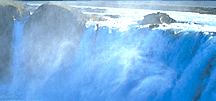|
Capercaillie - Tetroa urogallus
"The horse of the woods", or Capercaillie, is the old Gaelic name for the largest member of the grouse family, distributed through most of northern Europe and particularly common in Norway. A proper name, indeed, for when this huge bird is flushed and it makes its thunderous escape through the brush and brambles, it could seem to resemble a startled horse in flight. Males can weigh as much as 15 pounds and measure nearly three feet in length.
The capercaillie (Tetroa urogallus), or tiur, as it is known to Norwegians, is a much prized game bird that has been immortalized in song and legend; even rosemalere have recorded its charisma and beauty. Fried capercaillie, served with tyttebaer syltetoy (lingonberry jam), is a delectable treat for the Norwegian palate, much as turkey, with cranberry sauce, is a culinary delight for Americans.
It is not surprising, then, that efforts have been made to introduce this delicious game bird to the United States. Capercaillie were brought over and set free, but perhaps like the Norwegian novelist Knut Hamsun, whose residence in the States was all too brief, they were unwilling to accommodate the change, saying in effect, "thanks anyway, but we like it better back home!"
On the average, capercaillie cocks weigh about 8 pounds, hens about 4.5 pounds. The male is richly adorned with colorful plumage. The head and neck are bluish-black, the breast a dark, iridescent green. The wings are mottled brown and the tail feathers, which can be fanned out into a spectacular display during courting, are beautifully embellished with white markings on dark bluish-green. The bright spot is a red patch, just over the eye, set off by the dark plumage around it. The more demurely attired hen is mottled dark brown, white and ochre.
A clutch of six to ten brown-spotted eggs is laid in spring. Favorite foods include a variety of berries, insects, and in winter, pine shoots, which impart a pleasing pungency to the flesh. The preferred habitat is pine forest with scattered birch and poplar, interspersed with intervals of meadow. Spring is the mating season, when the males perch conspicuously on pine boughs and declare their presence by "booming" - the characteristic mating cry of cocks in the grouse family.
The first scientific effort to introduce these birds to North America was in 1904-05, when more than 200 capercaillie and black grouse (Tetrao tetrix), another popular game bird, were set loose on Grand Island, in Lake Michigan. Within two years, all had vanished. A later attempt this time in the Apostle Islands, in Lake Superior, was equally unsuccessful. The common explanation for these failures is the denseness of the forest where they were released, the paucity of berries, and possible predation of foxes and other small mammals.
Higher summer temperatures than those in Norway were also deemed a factor. It seems probable, nonetheless, that the vast North American continent, with its endless
variety of habitat, has some that would prove hospitable for these marvelous creatures. Meanwhile, the "horse of the woods" is sure to thrive in Norway's forests, as it has for eons, continue to stir the pulses of birdwatchers and hunters - and please the Norwegian palates!
Back to Capercaillie Hunt Visit our Photo Album Back to Top
|

